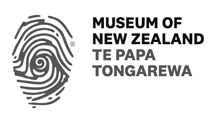John Meilink and Joe Cheek
John Meilink and Joe Cheek
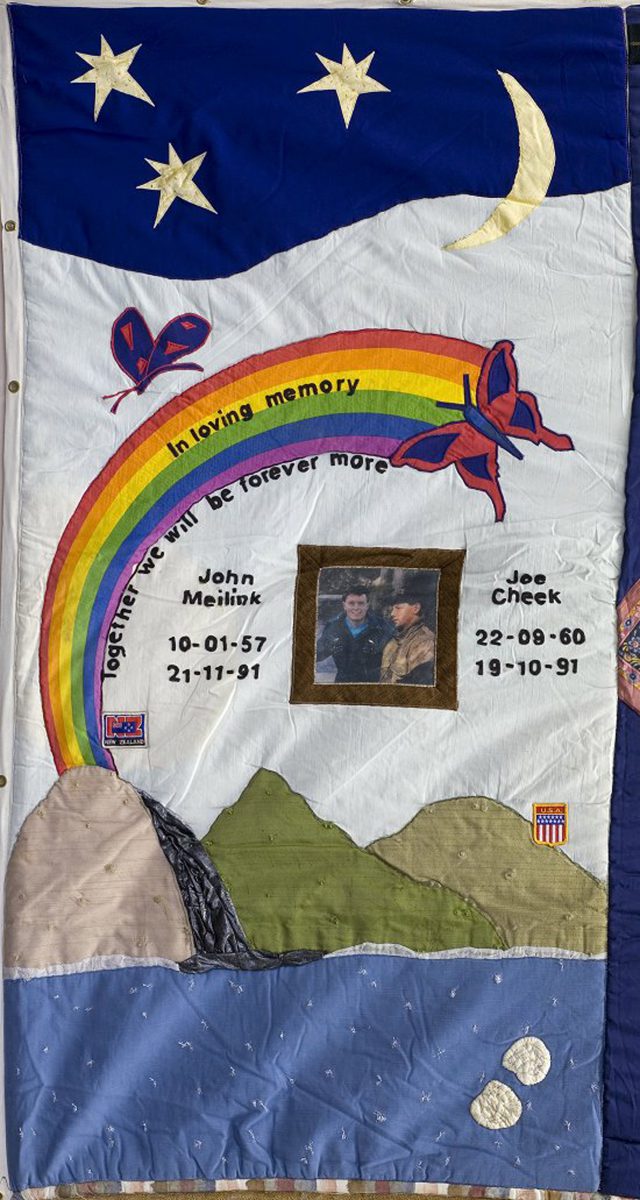
Sadly, at the time of setting up this website, we have no information about this panel.
Add a memory to this panel
If you wish to add your memories to this page, please get in touch.
Roderick Ross Stewart Horn
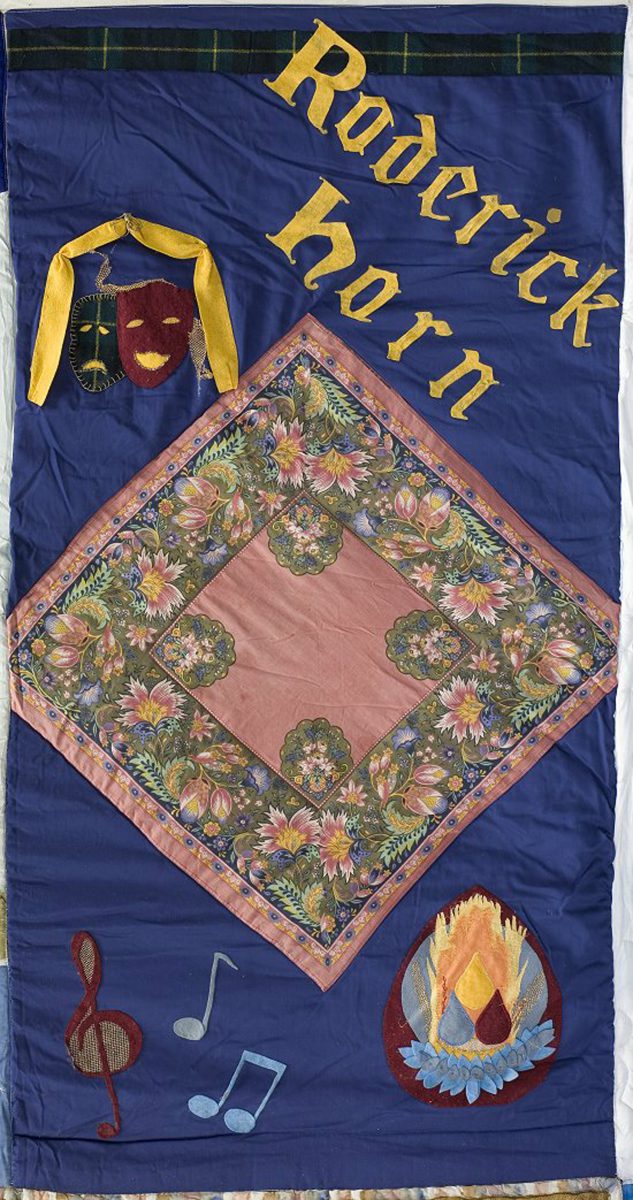
Roderick was born in Hawkes Bay, the only son of Ted and Mary Horn, and brother of Mary Twentyman.
He is remembered by his friends as a man of passion and wit. He was passionate in his career as an actor and director, passionate in standing up against social injustice, whether it be suffered by dispossessed Tibetans or people living with HIV and AIDS. His wit informed his deep love of literature and music, especially opera.
His devilish sense of fun made friendship a delight.
Early in his career, Rod was a member of the Old Vic and the Royal Shakespeare Companies. He came back to New Zealand in the late 60’s and is remembered in Auckland for his Hamlet, Marat-Sade, Hadrian VII, and Dames At Sea at the Mercury Theatre, under the direction of Tony Richardson.
On returning to England he worked as a staff producer for the English National Opera. A few years later he rejoined the Royal Shakespeare Company and toured with Nicholas Nickleby to the United States.
He decided to make his home in Los Angeles. There he saw Peter Wells’ film A Death in The Family and, being HIV positive, he decided to come back to New Zealand. He worked at the Mercury again, as well as Downstage and The Court. He won an award for Talking Book of the Year and took an active part in the NZ AIDS Foundation (now Burnett Foundation Aotearoa).
Roderick faced his illness with great dignity and courage, helped by his Buddhist faith and his loving friends. He died on 5th April 1992 aged 58. At his funeral, he was given a long round of applause for a life well lived.
The following photo is of the three people who read the names on The Quilts at the first unveiling of the New Zealand Quilt in October 1991. Roderick is the person on the right. The other two are, at present, unidentified.

Bill has this to say about Roderick:
Rod was a dear friend whom I met long before I came to NZ. He came to the UK and had to do National Service in the Army. I met him in the Rhine Army Theatre Club in 1957. With Peter, David and myself, he took part in productions and we stayed in touch for years after that. I came to Auckland later as Planning Director for the City but only met him again shortly before he died and I had returned to the UK. He gave greatly to our world and looked deeply into his particular place in it. My wife and David mentioned above still talk of him with admiration and affection.
Bill Berrett.
Added July 2013
Bill also sent us this photo of Rod (on the left with Michael Jones) taken in Germany at Headquarters BAOR, 1958

Felicity has this memory of Roderick:
I remember Rod Horn only as a stunning actor.
I was very young when I used to watch him on the Mercury, but I have never forgotten him.
He had great presence and influenced me enormously.
Arohanui, Rod.
Added August 2014
Add a memory to this panel
If you wish to add your memories to this page, please get in touch.
Rudi ten Have and John Eade (Noddy)
Rudi ten Have and John Eade (Noddy)
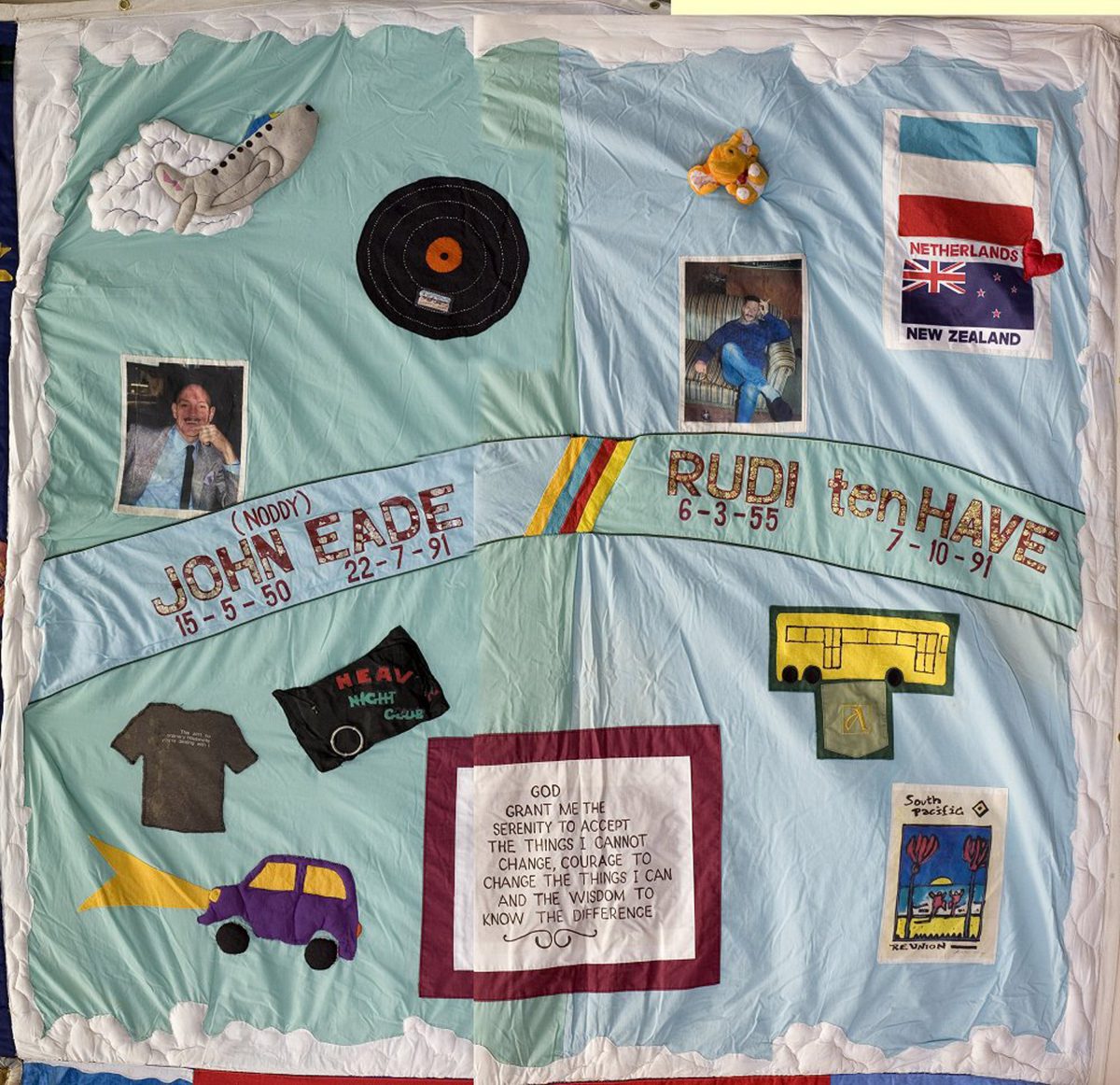
Gerald Waters, Gilbert Smith and friends made these joint panels to celebrate Rudi and John’s life together, with aspects of their personal lives included.
John
Making this joint panel was not easy. It was a very emotional experience, which took five months to complete. We were so proud when we finished, because neither of us had sewn anything more than buttons onto shirts before this. The Quilt helped us move through the grieving process. It was made with love and gave us the chance to show others the positive and wonderful people who were John and Rudi.
John was born in Wellington, the only child of English parents.
During his late teenage years John drove a purple Mini around the Wellington area which became very well known at certain haunts in his home town. This explains why we sewed the purple Mini onto his panel as a memorial to his home town and the passion he had for driving fast cars for the rest of his life.
John loved to travel. He lived in England and explored Europe extensively in the 1970’s, visited America several times, as well as living in a number of New Zealand cities throughout his adult life. He was happiest when he was preparing for yet another adventure. The aircraft flying through the clouds expresses his love of flying and exploring the world.
The record shows his love for music, which varied from classical to rock. His career as a radio announcer with Radio New Zealand for 20 years caused him to move all over the country, including Invercargill, Palmerston North, Masterton and Wellington, before settling in Auckland. He worked for Classic Hits (Auckland) for 10 years. The record blends his love of music and career, which was such a huge part of his life.
Also on the Quilt is the pillow with Heaven Night Club (London). This represents his love of night life, fondness of parties and enjoyment of people. John could talk about anything to anybody. The sex ring expresses how proud John was about being gay and his fascination with all things sexual.
The tee-shirt is cut down from one he brought back from San Francisco. It helps to explain his sense of humour, as well as his attitude of “I am what you see”.
For John, the Serenity Prayer was about getting his life together with emotional challenges from his youth. Like Rudi, John went to Queen Mary Hospital in Hanmer Springs for addiction therapy.
Gilbert Smith knew John (Noddy) for 15 years. As Gilbert says, “A lot happens in that time. He was my friend, the person I could confide anything with. The most positive person I’ve ever known. He had a wonderful sense of humour. I will forever miss his love and I will never forget him for all my life”.
John was a wonderful person. Before his relationship with Rudi, he had many other partners, all of whom became his best friends. This shows John’s ability to have people love him from when they first met until his death.
Rudi
Rudi was born in Amsterdam, Netherlands, the oldest of two children. His sister, Elaine, now lives in Canada. His parents, Rudy Senior and Bep remain in Amsterdam. Rudi loved to travel, with numerous visits through America, Europe, and Australia.
The flags of both countries represent his birth country and his adopted country. He emigrated to New Zealand in 1983, saying he loved his country for its natural beauty and friendly people. His favourite pastime was going to the beach and for bush walks.
Rudi’s passion was trams and buses, which is represented on the Quilt by the yellow bus. He had a degree in town planning and anthropology, but loved his job as a bus driver for the Yellow Bus Company. He drove buses the same way he lived life – fast, passionate, but always friendly. He had some wonderful stories of driving experiences.
The pocket from his ARA bus driver uniform has the company’s emblem, which Rudi designed. This logo was used by the company for many years.
Rudi had an off-beat sense of humour. The combination of his Dutch upbringing with the relaxed New Zealand attitude drove his wonderful humour.
The painting at the bottom of the Quilt was painted by Rudi for Greenpeace. He won a design competition with this painting, so Greenpeace printed tee-shirts which sold out immediately. It is a true expression of Rudi’s love of New Zealand, with the sea, trees and sun. His father was so proud that he purchased many tee-shirts to give to Rudi’s friends and family back in the Netherlands. Rudy Senior and Bep had another painting by Rudi converted into postcards, which they sold to fundraise for the Dutch AIDS Foundation.
The toy elephant represents how Rudi sometimes gave the impression of being ethereal and dreamy, but to us who knew him, he had the determination and strength of an elephant and the softness of a cuddly toy.
The Serenity Prayer bonds both Rudi’s and John’s Quilts. It represents their seven years together as a couple. The prayer has been important and given them strength during difficult periods of their lives. For Rudi, it was a part of getting life together and overcoming an alcohol addiction through the help of Queen Mary Hospital (Hanmer Springs) and Alcoholics Anonymous.
The clouds surrounding the panel imply Rudi’s spirituality and new age beliefs, including crystals and so on. The clouds can also be interpreted as John’s and Rudi’s spirit which will always be floating around the universe looking after those of us left behind on this earth.
A single Quilt with exactly the same design as this one was sent to Rudi’s parents who, in turn, donated it to the Netherlands Quilt Project (see link above, just below the photo of the joint panel).
We knew Rudi through good times and bad times. He was wonderfully eccentric. He always saw the beauty around him, expressed himself through art, and was always loving and true to his friends. He was an amazingly talented man with a passion for life.
Rudi is deeply loved by his friends and family. He shall never be forgotten by those who knew him.
We also have this story about Rudi and John’s panels written by Gilbert.
My name is Gilbert Smith. I’m forty years old, and I work in a video shop, which is an extension of my hobbies and enjoyment. I came into the Quilt Project as a result of Gerald, a friend of mine who asked me to help make a quilt for a friend who had died some months before.
We decided that because Rudi and Noddy were in a partnership, we would make a joint quilt. Rudi was an artist and did quite flamboyant sorts of artistry, cartoonish in a way, and Noddy had a really fun side to his personality, so we thought we would make the panel with cartoon aspects in the design and make it a fun way of looking at their lives.
On Noddy’s quilt, who was my best friend, we put a car, a plane and a record. The car signified his life in Wellington when he was renowned for travelling around all the spots. Everyone knew him by his car, which was a bright purple. We made this little mini out of feeling so people could see that connection of his to Wellington, which is where he was born and brought up. It was also a remembrance of the seventies, which was quite a great time for him.
He was a radio announcer and had a great love of music, so I put the Radio New Zealand symbol, where he worked for sixteen years, through the middle of it. He just loved to travel, had a real travel bug. He just wanted to zoom through the skies all the time so we put that aspect on.
Across the middle of the quilts, we put their names in a rainbow type of arc. We were going to do a rainbow but thought that with all the other colours it would be just a little too garish.
Gerald did the bulk of Rudi’s quilt, on which he put a T-shirt which Greenpeace commissioned Rudi to do. They really loved it and it was made into postcards as well. It was a picture of Rangitoto Island out in Auckland Harbour and has aspects of the Pacific signified in it as well.
He was from Holland so we put the flag of the Netherlands and the flag of New Zealand to signify his Dutch and New Zealand connections. In making Rudi’s quilt, we also made another one to send back to his parents for the first anniversary of Rudi’s death. They knew we were making the quilt but they didn’t know at the time that we were making an extra one to send to them. They were over the moon, ecstatic about it and they’ve got involved with the Quilt Project since, in the Netherlands. We really felt we did something positive by doing that.
Rudi was an Auckland Regional Authority bus driver at one time, quite a stroppy ARA bus driver in some ways, and so we put a bus with the ARA symbol on the quilt as well. Designing the bus was quite fun, cutting all the little bits of fabric out to make the windows was quite neat.
We put the serenity prayer in the centre of the quilt because it related to them both really strongly. Rudi had had problems with alcohol at one time and was a regular at Alcoholics Anonymous. The serenity prayer was part of who he was every week. Noddy also had some problems, emotional problems more than anything really, and he went to Hanmer for treatment for a while. He came back with a bit of the New Age type of thinking that moved him each day in his life. So the serenity prayer locked them together and that’s why we put it right in the centre of both the quilts.
On Noddy’s quilt I also put a padded pillow with ‘Heaven Nightclub’ on it because when he went to London, Heaven was like wow, it was the place and he just raved about Heaven, how great it was and how wonderful. I also sewed on a cock ring because sex was a very big part of his life as it is with most of us. It just signified something that I didn’t think was smutty or anything like that. It was just a part of him if you knew him as a person. I also put a little T-shirt there that has a saying on the pocket that emphasised the fun side of his personality. He brought the T-shirt back from the States and gave it to me. It had, “This ain’t no ordinary housewife you’re dealing with” on it.
That really encompasses the making of the quilts for me. As a result of making the quilts, we built a good friendship with the people who helped us along with each workshop that we went to. It was a lovely, loving environment to go to and we decided to keep an involvement there maintaining all the quilts that are going around the country. When they come back, because of the folding and unfolding process, things tend to break down and fall off and they need to be constantly in a state of stitching. So I enjoy that, doing a bit of needlework, within the capabilities of these clumsy hands.
We handed the quilt over to Nicki (then Convenor of The Quilt Project), and she took it to Washington DC for the big international display there in 1992. When she brought it back, we sewed it into the blocks and from that time it has travelled up to Dargaville and around several other provinces in the North Island (and since Gilbert wrote this, the South Island as well).
After all those months of working on it, it becomes like your baby really. It was quite difficult to part with it, and say, “Here it is.” You give it to them tentatively, “Look after it with gentle loving care.” It is very difficult to do that. It’s like having a little bit of that someone with you, it really is. You know you’ve pit different aspects of their life there, you know their names are embellished on it. It’s like holding a little piece of their life, and it’s a big part of getting through the grieving process to do it and let it go, and at the same time do something rewarding for the community.
Add a memory to this panel
If you wish to add your memories to this page, please get in touch.
Nicholas (Nick) Edwards
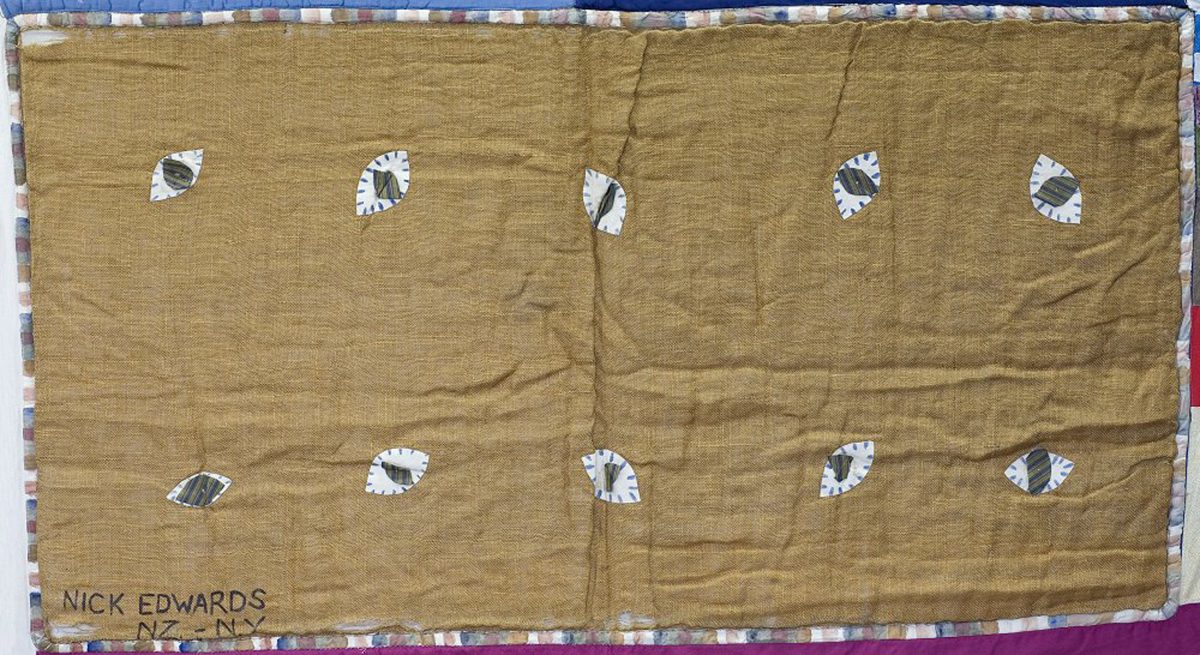
Nicholas was a partner in Serpentine Studios in New York City which specialises in interior designs for homes, public buildings and restaurants. He painted murals at the Guggenheim Museum, the Brooklyn Botanic Garden, the Lutece Restaurant, and other local and foreign restaurants. Also, he advised art collectors, specialising in 20th-century decorative objects made in silver.
Nicholas was born in Wellington, New Zealand on the 28th December 1949. He was a pupil of Auckland Grammar School. He graduated LLB from Auckland University and was admitted to the Bar in the High Court of Auckland.
Nick died in his Manhattan home on the 16th April 1992, aged 42.
We have also received some photos depicting some of his design work. The studio he was a partner in specialised in screens.
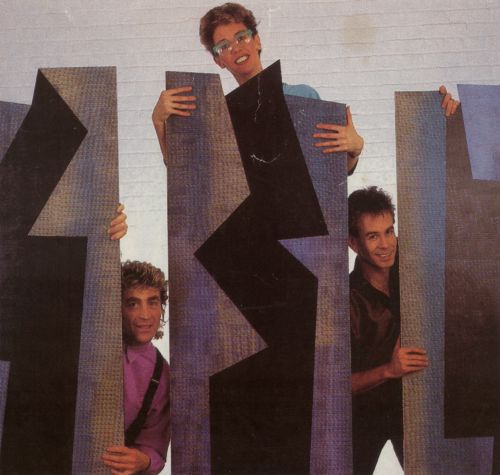

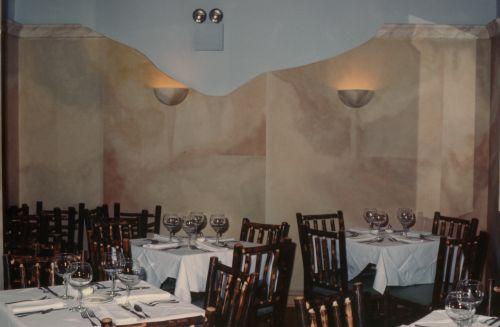
Photos of some of Nicks work – above (1), a screen from a New York apartment, and (2), for a restaurant (now destroyed) on New York’s West Side.
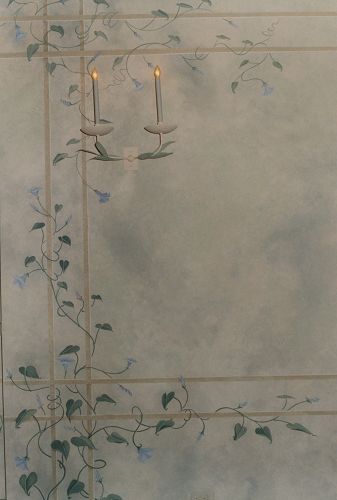

More photos of some of Nicks work – on the left, work done for the Lutece Restaurant in New York and on the right, a mural said to be done for the Guggenheim Museum bookstore.
Add a memory to this panel
If you wish to add your memories to this page, please get in touch.
3 Anonymous, Dunedin
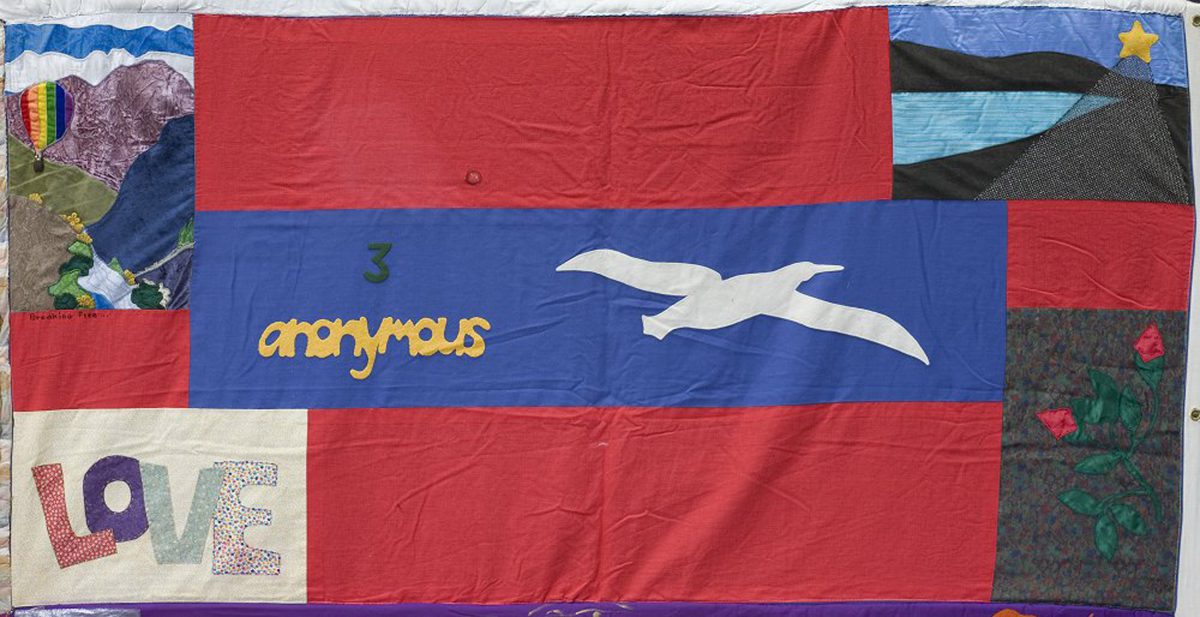
This panel, made in 1992 and crafted in vibrant, primary colours, for celebration is a tribute to the lives of three people who died of AIDS in the Otago region.
Its design is almost theatrical, planned for its effect rather than to reveal personal details or memorabilia.
It incorporates the blue and gold Otago colours in its central portion. The blue background with the green and gold legend ‘3 Anonymous’ makes a poignant statement alongside the white albatross, another specific Otago symbol. This giant, beautiful bird soaring upwards with outstretched wings, also represents ‘taking off’ and going to places unknown, and later, returning home to the colony for rest and recreation.
The person who pieced the quilt together desperately wanted to put the three names on the quilt panel but for various reasons was unable to do so. This was a source of ‘huge frustration’ and a ‘wistful, sad thing as well’. The panel maker said of the people represented, ‘they’re not anonymous but they had to remain so, and what does this say about the status and acceptance of HIV and AIDS in our community?” However, instead of names, these people have been given an identity based on regional consciousness and pride.
Contributions from three people featured on this panel. In the top right-hand corner, a peaceful scene of the silhouetted hills around the Otago harbour is depicted with starlight and moonlight shimmering down on them. This serene image contrasts with the patch in the bottom left-hand corner. Its creator says that the single word ‘LOVE’ made up of multi-coloured, tiny, floral fabrics on a flowery background is ’a bit of witticism’ and ‘homage to the flower people, San Francisco’ which relates back to where the quilt project started. It also recalls boys on Fire Island popping amyl nitrate, cross-dressing, and all the camp stuff of those nostalgic days – and nights.
The patch-worked illustration in the upper, left-hand corner seems to echo the albatross theme of flight. A Hot-air balloon with a canopy of gay, rainbow colours carries a basket which rises high into the clear blue atmosphere above the Taieri Gorge landscape, near Dunedin. The words ‘breaking free’ have been penned beneath.
In the bottom right-hand corner, a combination of embroidery and applique has been used to create a traditional symbol of love – two bright, red, satin roses with intertwined stems and leaves. The patterned background fabric repeats the green and red colour tones and compliments the plain, dominant, primary colours around it.
This panel is an expression of love and affection that is overlaid with some defiance. The person who initiated the idea for the quilt panel and who stitched the separate contributions together said, ‘I’m doing this because it’s the only thing I can do. I’m standing up for these people. Somebody’s going to acknowledge them. I don’t care what you say.”
In May 1997, The Quilt Project received a letter from Joka Neuman one of the people who made the panel, who wrote, in part:
I made a patch on the Otago/Dunedin block for two friends of mine who were HIV positive, and one, Murray Howson, has since died.
I promised him on one of his last days that I would add his full name to the patch if I “got my hands on it”. The rainbow and albatross is my patch with the rainbow-hued balloon.
I feel honour bound to add Murray’s name as he has consented …
Add a memory to this panel
If you wish to add your memories to this page, please get in touch.
‘Procession Of Hope’

This Quilt was created by Robin and family, and Thora in memory of all people who have died of an AIDS-related condition.
While I know the New Zealand Quilt Project needs ongoing financial support I wanted to do something as well as send money.
I have a large extended family who watched and helped with interest as the Quilt has progressed. It was a valuable tool to talk about AIDS and the effects on us all. Hopefully, they learnt about love, compassion and understanding.
Also, that love truly is a gift that goes from heart to heart.
Yours sincerely,
Robin
Add a memory to this panel
If you wish to add your memories to this page, please get in touch.
Nigel Barraud

From the stories folder that accompanies The Quilt to displays:
The purple background reflects the rich wonderful depth to Nigel and his passion for life and people.
He lived both in New York and New Zealand and walked ‘the yellow brick road’ between both.
He loved to sing and enjoyed musicals and opera. He loved to cook. Clothes with ‘labels’ were a passion.
The poem was written for him by his friend, Maureen.
Nigel came back to New Zealand in 1991 and immediately set about to implement the “12 on 12” programme (a peer support programme of 12 HIV positive people meeting together for 12 weeks) he had experienced in London. He worked with Joe Kelleher of the NZ AIDS Foundation (now Burnett Foundation Aotearoa) and soon the first “12 on 12” began. These early groups formed the basis from which Body Positive in Auckland grew. Nigel was too sick to attend the Opening of Body Positive but knew that his dream had been born.
The red ribbon as a symbol of HIV awareness and support had been used in the USA for several years but the use and distribution of it had not really caught on in New Zealand. Red ribbons cut from soft ribbon and inserted with a small pin were given out at Nigel’s funeral and the idea took off.
Add a memory to this panel
If you wish to add your memories to this page, please get in touch.
Other photos of this block
Panels in this Block
| Panel Name | Life Years | Panel Link |
|---|---|---|
| ‘Procession Of Hope’ | View Panel › | |
| 3 Anonymous, Dunedin | View Panel › | |
| John Meilink and Joe Cheek | 10 January 1957 - 21 November 1991 and 22 September 1960 - 10 October 1991 | View Panel › |
| Nicholas (Nick) Edwards | 28 December 1949 - 16 April 1992 | View Panel › |
| Nigel Barraud | 1952 - 1992 (one week after his 40th birthday) | View Panel › |
| Roderick Ross Stewart Horn | died 5 April 1992, aged 58 | View Panel › |
| Rudi ten Have and John Eade (Noddy) | 6 March 1955 - 7 October 1991 and 15 May 1950 - 22 July 1991 | View Panel › |



